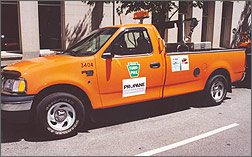Propane Vehicle Emissions

Compared with vehicles fueled with conventional diesel and gasoline, propane (also known as liquefied petroleum gas or LPG) vehicles can produce significantly lower amounts of some harmful emissions and the greenhouse gas carbon dioxide.
Vehicle Emissions: Propane vs. Gasoline
Testing has been performed to compare the emissions of light-duty propane vehicles versus light-duty gasoline vehicles. For detailed results of some tests, see Compressed Natural Gas and Liquefied Petroleum Gas Conversions: The National Renewable Energy Laboratory's Experience (PDF 262 KB) and Fact Sheet: Ford F-250 Bi-Fuel Propane Pickup (PDF 852 KB). Download Adobe Reader.
The emissions performance of modern propane vehicles is far superior to that of previous generations. A major reason for this is the strict U.S. Environmental Protection Agency (EPA) emission requirements for converted vehicles.
The EPA calculated the potential benefits of propane versus gasoline based on the inherently cleaner-burning characteristics of propane, summarized in Clean Alternative Fuels: Propane (PDF 71 KB). (Download Adobe Reader).
Potentially lower toxic, carbon dioxide (CO2), carbon monoxide (CO), and nonmethane hydrocarbon (NMHC) emissions
Rich calibration shows high NMHC and CO emissions, but lower nitrogen oxide (NOx) emissions
Lean calibration shows slightly higher NOx emissions, but lower CO and NHMC emissions
To perform more in-depth analyses of alternative fuel versus conventional fuel emissions, see the AFDC Propane Emissions page.

